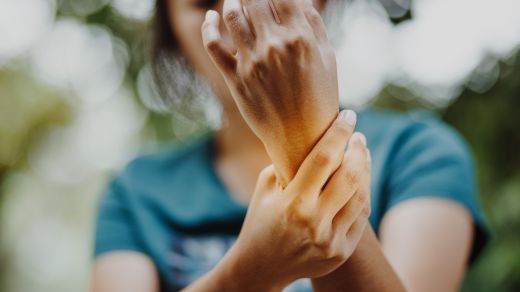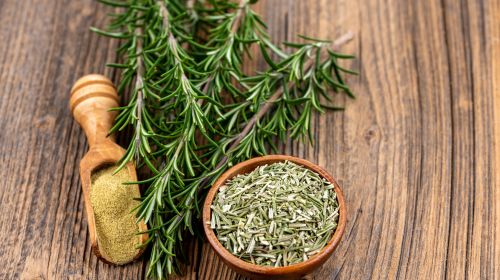Arthritis is a painful inflammation of the joints that, if left untreated, can lead to serious joint damage. In contrast to osteoarthritis, arthritis can also occur in young people and children. Further differences, typical symptoms and how joint inflammation can be treated!
- © anut21ng Stock – stock.adobe.com
Quick overview: Frequently asked questions and answers
What is the difference between osteoarthritis and arthritis? Osteoarthritis describes the wear and tear of joint cartilage, while arthritis is inflammation in the joints.
How does arthritis manifest itself? Pain, swelling and redness are typical of arthritis. The affected joint is often overheated.
How does arthritis go away? In the case of acute inflammation, medications such as painkillers or cortisone are used. They often heal again without any consequences. Chronic joint inflammation is usually not curable, but can be easily treated. Therapy depends on the cause.
Article contents at a glance:
What is Arthritis?
The term arthritis comes from Greek and means something like inflamed joint. Joint inflammation can basically occur in any joint in the body.
If only one or a few joints are affected, experts speak of monoarthritis or oligoarthritis. If several joints are diseased, this is called polyarthritis. Joint inflammation can occur acutely, but can also take a chronic, i.e. long-term, course.
Arthritis: Typical symptoms
Typical signs of joint inflammation are:
overheat
Redness
swelling
Pains
Pain at rest that gets worse with exertion
Possibly palpable joint effusion (accumulation of fluid inside the joint)
sometimes pus formation in the joint
At the beginning of the illness, flu-like symptoms such as fever, fatigue and loss of appetite may also occur.
In the later stages, those affected usually complain of morning stiffness in their joints, which means that even simple activities such as closing a button or grasping an object are only possible with great effort and pain.
Arthritis in children
Joint inflammation can also affect children. Small children often refuse to walk and want to be carried. Flu-like symptoms are also common in children associated with arthritis.
Arthritis: causes and forms
Arthritic inflammation can arise in different ways. Depending on the possible cause, arthritis is divided into the following forms:
Rheumatoid arthritis: By far the most common form of arthritis is rheumatic arthritis. Rheumatoid arthritis is an autoimmune disease in which the immune system classifies the synovium as foreign and attacks it.
Juvenile idiopathic arthritis: If the disease begins before the age of 16, experts also speak of juvenile idiopathic arthritis (children’s rheumatism). The cause is still unclear. Heredity is believed to play a role.
Psoriatic arthritis: In around a third of all psoriasis patients, in addition to the skin changes, joint inflammation also occurs, which is known as psoriatic arthritis. The disease develops due to an autoimmune reaction.
Infectious arthritis: Another common cause of arthritis is infection with bacteria or other germs. In most cases these are staphylococci and streptococci as well as viruses and fungi. These usually enter the joint from outside, for example through a wound or during an operation. In addition, pathogens can also migrate from another source of infection in the body via the bloodstream into the joint.
Reactive arthritis: The so-called reactive arthritis is also one of the infectious forms of arthritis. This leads to acute joint inflammation as a reaction to an infection distant from the joint, such as a urinary tract, respiratory or gastrointestinal infection.
Arthritis caused by metabolic diseases: Metabolic diseases such as gout can also lead to joint inflammation. This is due to greatly increased uric acid levels in the blood. Uric acid crystals form which are then deposited in the joints. This leads to acute inflammatory reactions in the joints with severe swelling and pain.
Arthritis in osteoarthritis
Joint inflammation can also occur as a result of osteoarthritis. However, both diseases must be separated from each other. While osteoarthritis is a degenerative disease with gradual, usually age-related, joint wear and tear, arthritis is an inflammation of the joints.
However, the constant rubbing of the joint surfaces in advanced osteoarthritis can lead to acute inflammation, i.e. arthritis. In this context, doctors also speak of activated osteoarthritis.
Diagnosis of arthritis
If joint inflammation occurs, the medical history (anamnesis) is first taken. Complaints and previous illnesses are recorded. A detailed physical examination is then carried out, during which the joint is visually examined and palpated. Flexibility is also tested.
Laboratory tests
A blood test is usually also carried out. The pathogens that caused joint inflammation are usually found in the blood. Increased inflammation levels are almost always detected. In addition, other values can be measured:
If rheumatoid arthritis is suspected, special rheumatoid factors can also be tested.
If gout is suspected, an examination is carried out to determine whether the uric acid levels in the blood are elevated.
If infectious arthritis is suspected, some pus or fluid from the joint effusion can be taken with a needle and this sample can then be examined for pathogens.
Imaging procedures
To further assess the disease, imaging procedures such as x-rays, ultrasound, computer tomography (CT), magnetic resonance imaging (MRI) or joint endoscopy can also be carried out.
Arthritis: Treatment depends on the cause
Arthritis should be treated as quickly as possible. If left untreated, the inflammation can attack the cartilage of the joint and damage or even destroy its structure. Treatment for arthritis depends on the cause and form of joint inflammation.
Acute arthritis
Acute forms of arthritis are usually caused by an infection, but can also occur with other types of arthritis. If treated in a timely manner, they can usually heal completely without leaving any lasting damage. The following treatment options are available:
It is important to protect the affected joint, cool it and elevate it to reduce the swelling.
Painkillers from the group of non-steroidal anti-inflammatory drugs (NSAIDs) help to relieve pain (especially at night).
Depending on which pathogen is responsible for the inflammation, antibiotics, antiviral drugs, antifungal drugs and anti-inflammatory drugs and drugs that weaken the immune reaction such as diclofenac or cortisone are administered. These can be given as tablets or infusion. Sometimes the medication is injected directly into the joint.
In advanced stages, it may be necessary to surgically remove pus and fluid accumulations as part of a joint endoscopy.
The joint is then thoroughly rinsed. Medication can also be delivered directly to the site of inflammation.
Drainage can also help newly formed pus and joint effusion to drain away more easily.
Chronic arthritis
Chronic courses with recurring joint inflammation are usually caused by existing underlying diseases such as gout, psoriasis and rheumatism. It is necessary not only to treat the disease in question, but also to take preventive measures to prevent damage to the joints.
Rheumatoid arthritis
Rheumatoid arthritis is the most common permanent joint inflammation and cannot be cured. If detected early, progression of the disease can be effectively delayed and the symptoms can be sustainably alleviated. The therapy consists of several pillars:
Slow-acting basic medications combat the inflammation permanently, but only take effect after several weeks.
For the acute treatment of inflammation, fast-acting cortisone medications are therefore initially used.
Nonsteroidal anti-inflammatory drugs (NSAIDs) also have an anti-inflammatory effect and also combat pain.
Physiotherapy and occupational therapy maintain mobility and help you cope better with everyday life.
In justified cases, joint-preserving operations can also be carried out and artificial joints can be used.
Gout arthritis
If you have gout, it is important to reduce uric acid levels and keep them low over the long term. To do this, it is necessary to avoid too much fat and sugar. In addition, uric acid-lowering medications can be given.
If an acute gout attack occurs anyway, special gout medications (colchicine), non-steroidal anti-inflammatory drugs (NSAIDs) and glucocorticoids are used. If these do not have the desired effect, interleukin-1β antibodies can also be administered.
Psoriatic arthritis
Joint inflammation caused by psoriasis cannot be cured, but it can be easily treated. They are also treated with anti-inflammatory and pain-relieving medications. Physiotherapy can also be used. Basic therapy also includes biologics that dampen the excessive reaction of the immune system.
Arthritis: What you can do yourself
In the case of arthritis, the following self-measures can also help to positively influence the disease. The following tips have proven to be effective:
Regular exercise is good for the joints. Sports that are particularly gentle on the joints, such as swimming, walking and cycling, should be practiced
Good footwear is recommended. The shoes should be comfortable and relieve pressure on the joints.
Excess weight puts strain on the joints. As a result, some rheumatism medications do not work as intended. It is therefore important to maintain a healthy body weight.
Nicotine promotes the development of inflammatory rheumatic diseases. Therefore, smoking should be avoided if possible.
Nutrition tips for arthritis
To date, there is no specific diet recommended for joint inflammation. However, a healthy and balanced diet is considered important.
Many experts recommend following the Mediterranean cuisine and eating a predominantly plant-based diet. Instead of lots of red meat, fish, which is rich in omega-3 fatty acids, should be on the menu more often.
People with gout in particular should change their diet to foods low in purines.
Reading tip: Low-purine and purine-containing foods – with a table to download
Exchange in self-help organizations
Especially in the case of chronic inflammatory joint diseases, it can be very helpful to exchange ideas with other patients. Self-help groups offer a good opportunity for this.
Those affected can contact the following self-help organizations, among others, where they can also find addresses for self-help groups near where they live:


